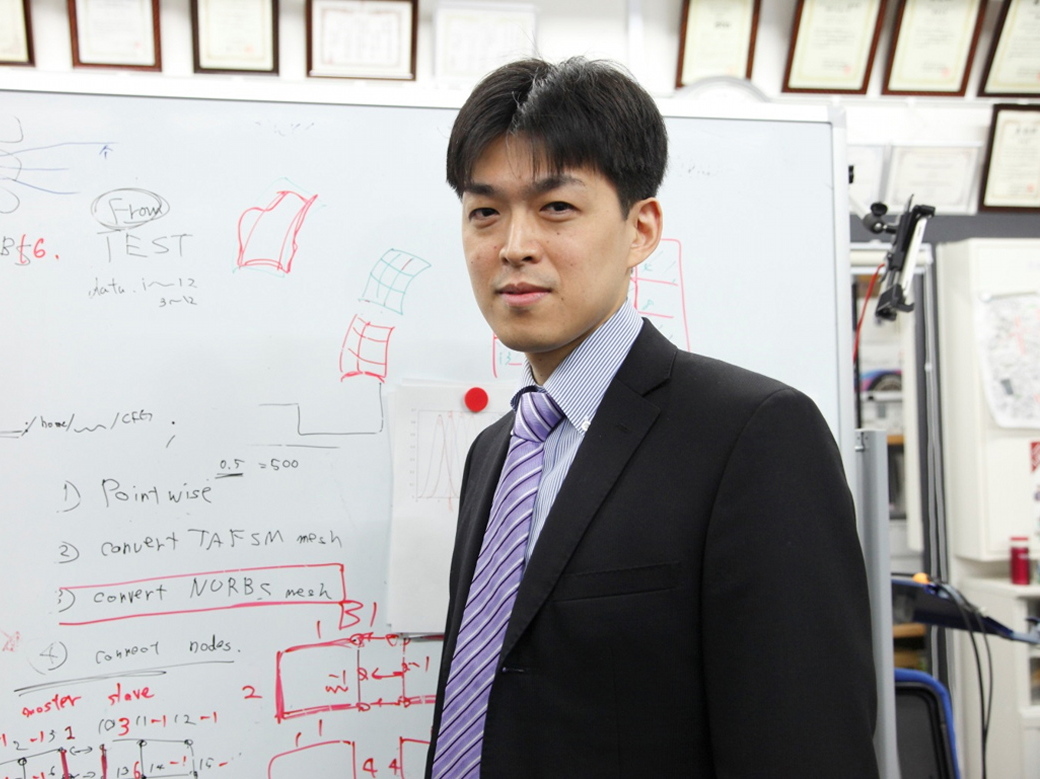Waseda Frontline Research Vol. 14-1: Skillful computational analysis unravels the complex interactions between fluids and structures (Part 1 of 3)
Fri, Mar 31, 2017-
Tags
Research on fluid-structure interactions in applied mechanics
Associate Professor Kenji Takizawa of the Department of Modern Mechanical Engineering, School of Creative Science and Engineering, Faculty of Science and Engineering
Addressing the moving-boundary challenge
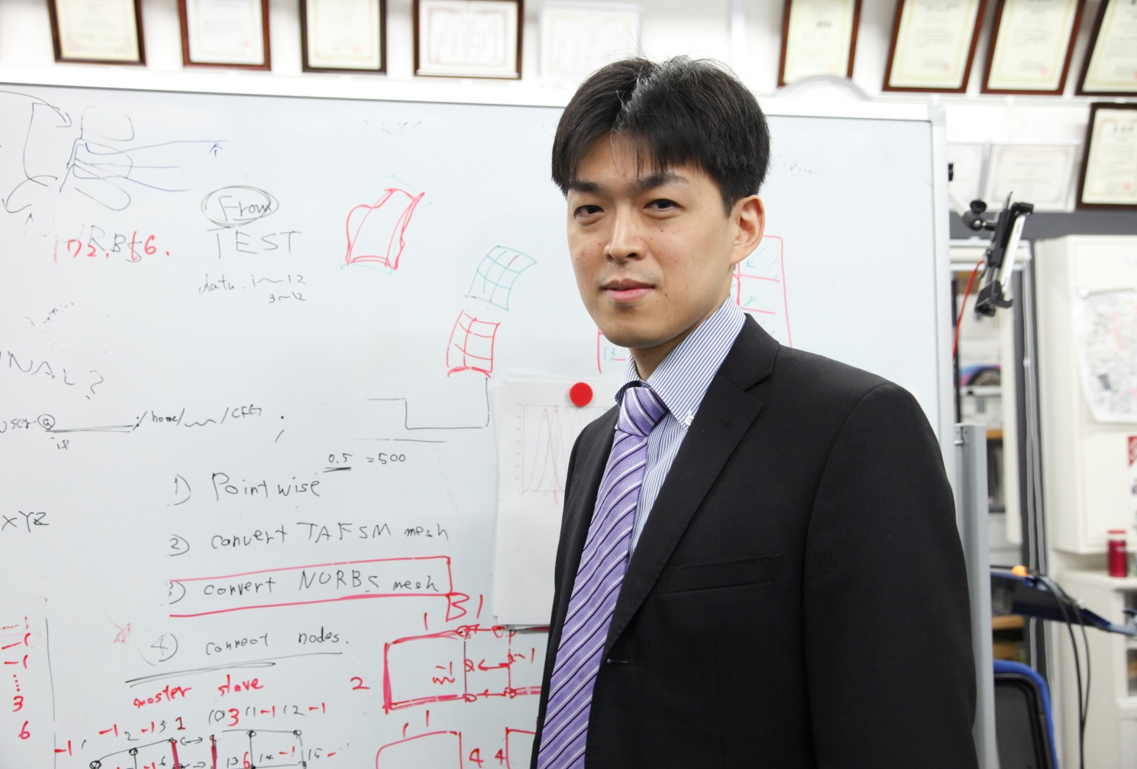 A natural phenomenon is not always visible to the eye. The best part of computational analysis is that it reproduces and visualizes such phenomena on a computer. Associate Professor Kenji Takizawa has reproduced motions of fluids such as air and water through computational analysis, and his research papers have been cited widely. In this interview, the Center for Research Strategy asked Professor Takizawa about his achievements. (Interview date: December 14, 2016)
A natural phenomenon is not always visible to the eye. The best part of computational analysis is that it reproduces and visualizes such phenomena on a computer. Associate Professor Kenji Takizawa has reproduced motions of fluids such as air and water through computational analysis, and his research papers have been cited widely. In this interview, the Center for Research Strategy asked Professor Takizawa about his achievements. (Interview date: December 14, 2016)
Interactions between fluids and structures
We encounter fluids such as air and water everywhere in our lives. Analyzing the physical characteristics of these fluids and utilizing them in manufacturing or, in general, engineering, is one of the most important studies in mechanical engineering, which is called fluid mechanics.
Fluid motion is difficult to visualize, so computation is very helpful in engineering analysis. Therefore, computational fluid mechanics could be considered as a field of computational engineering. In computational fluid mechanics, we model physical phenomena of fluids and aim for numerical analysis using computers and reproduce physical phenomena. The scope of this research includes utilization in manufacturing.
In this field, presence of moving boundaries create challenges in modeling and numerically analyzing the physical phenomena of how fluids and solids interact with each other as the boundaries between them move. In computational engineering, structural mechanics (or solid mechanics) analyzes the shape changes of structures when they are subjected to forces, and fluid mechanics analyzes the motion of fluids such as the flow of air or water. Addressing moving-boundary problems requires knowledge and skills across these two disciplines, so they are difficult to analyze.
Among the moving-boundary problems, I am mainly working on fluid-structure interactions (FSI), which occur when the fluid mechanics forces deform the structure. The change in the structure’s shape causes a change in the fluid flow. Our goal is to take such physical phenomena in which interactions occur with strong mutual dependence and reproduce them accurately on a computer.
Examples of FSI include the phenomena of a piece of paper or leaves falling in the air, or flags or sails flapping in the wind. While the soft structure deforms because of the airflow, the airflow is also affected by the motion of the paper, leaves and flags. The FSI occurs even in living bodies. The relationship between the blood and the heart and blood vessels, the relationship between the air we breathe and the lungs and trachea, and the relationship between things we consume and the stomach and esophagus are good examples of FSI in the body where fluid and soft structures interact. In this category, I am conducting research on blood flow, as I will describe later.
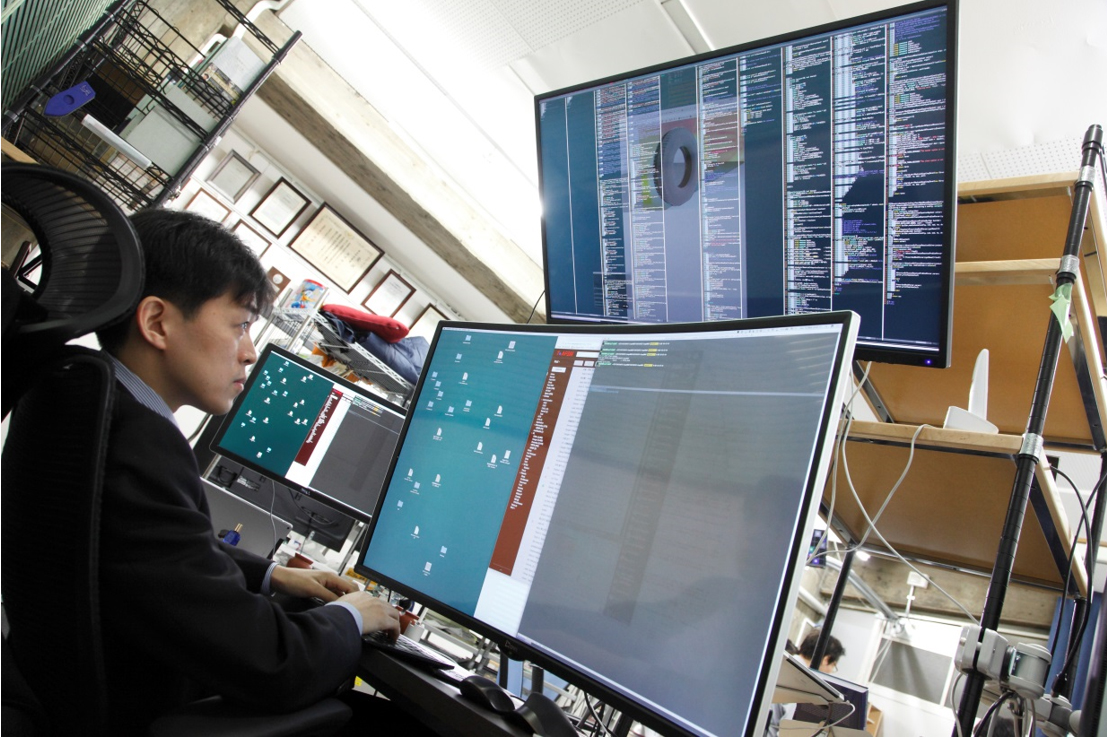
Photo: In the Takizawa Laboratory. Computational analysis with modern computer tools.
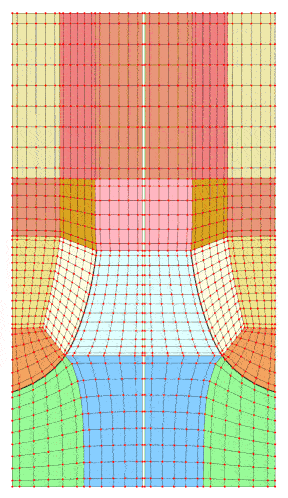
Figure: Example 1 of moving-boundary fluid mechanics analysis. (Source: Takizawa Laboratory)
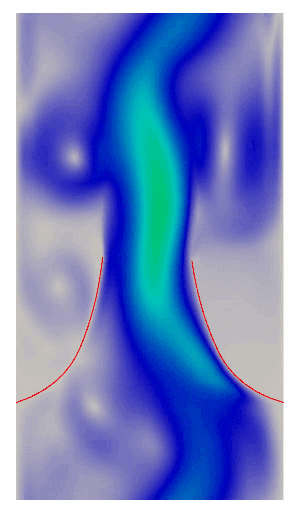
Figure: Example 2 of moving-boundary fluid mechanics analysis. (Source: Takizawa Laboratory)

Figure: A windsock in the wind. The cut is for visualization only. FSI modeling of a windsock. The main purpose of this computation is to show how effectively the FSI method deals with a very light and soft structure. See more details at the T*AFSM Website. (Source: Takizawa Laboratory)
Various ways have been proposed to model the FSI, but precisely representing the boundary between the fluid and structure has been a challenge. Additionally, in computational analysis of complex FSI, it is difficult to find an acceptable structure shape and deformation rate that we can start from.
In a joint research with Professor Tayfun Tezduyar of Rice University (Houston, TX, USA), who is also my mentor, we devised a method to address those challenges. Professor Tezduyar is a globally-recognized figure and leader in FSI research, who in 1992 published a paper on the space-time (ST) method*, which created an accurate framework for approaching the moving-boundary problems.
After obtaining my Ph.D. in 2005 and two years at National Maritime Research Institute, I held at Rice University research associate and research scientist positions from 2007 to 2011. During that time, I worked on FSI research with Professor Tezduyar using the ST method and participated in Orion spacecraft parachute analysis for and in collaboration with NASA (US National Aeronautics and Space Administration).
*Space-time (ST) method: An advanced method for solving the mathematical equations of the problem. Its best feature is dealing simultaneously with the space and time dependence of these equations. This makes it more straightforward to model the shape changes in time.
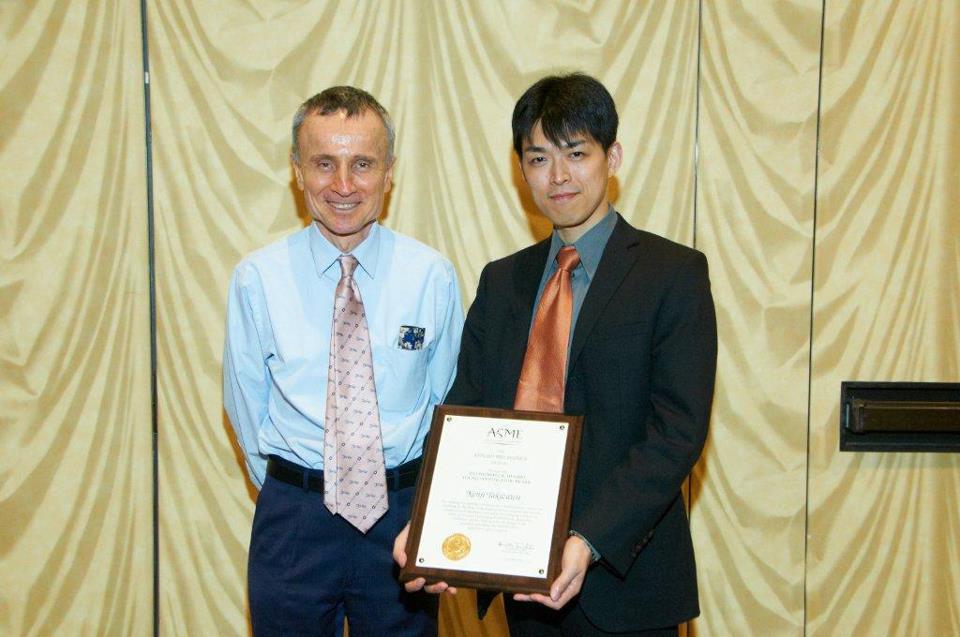
Takizawa attended the ASME awards ceremony in Houston. Photo: With Professor Tayfun Tezduyar, Rice University.
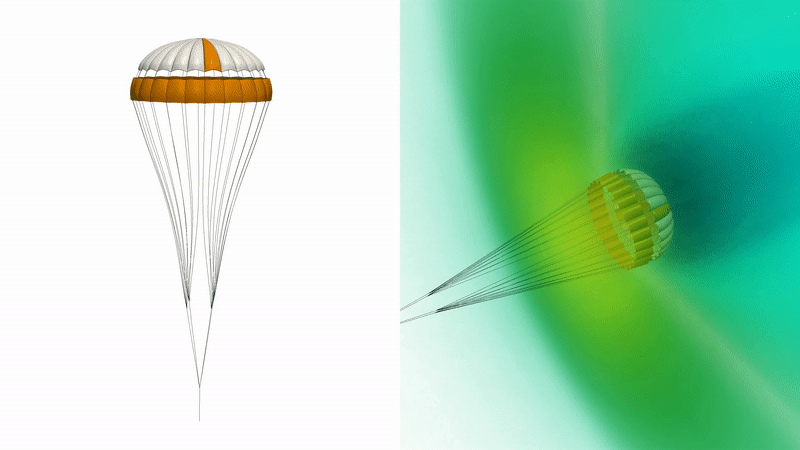
Figure: Computational analysis of compressible flow around a parachute for Mars landing. (Source: Takizawa Laboratory)
A parachute traps air with its soft fabric and reduces the speed of a descending object. The fabric part changes shape with airflow and vice versa. This is another example of FSI phenomenon. With NASA, I investigated the best design for the parachutes, so that the return from the atmosphere to the Earth becomes the most stable for the spacecraft, the astronauts and the scientific instruments. Even after being appointed an associate professor at Waseda, this joint research with NASA continued.
A great feature of the ST method is being able to deal simultaneously with the space and time dependence of the mathematical equations that need to be solved. That dependence is for all and infinitely many points in space and time. Computers cannot deal with infinitely many points. For this reason, to perform the analysis on a computer, it is common to represent the space and time ranges of the problem with a finite set of points called “grid” or “mesh.” However, in computation of moving-boundary problems, such as heart valve flow, without sacrificing the precise representation of the boundaries, the points in space vary as time changes. The variation could be in terms of the number of points, or their distribution in space, or both. The variation makes this class of computations challenging.
In the ST method, the representation in time is based on the same mathematical mechanism as in space. That is what makes the ST methods more accurate than the standard methods, where the space and time representations are not based on the same mechanism. Therefore the ST method enables a more accurate FSI analysis.
With that special accuracy, and with additional special methods that can accurately deal with contact between solid surfaces, we are increasing the scope and accuracy of our blood flow analysis. For example, we can now do more accurate aorta blood flow analysis, including the heart valve flow, with contact between the leaflets as the valve opens and closes.
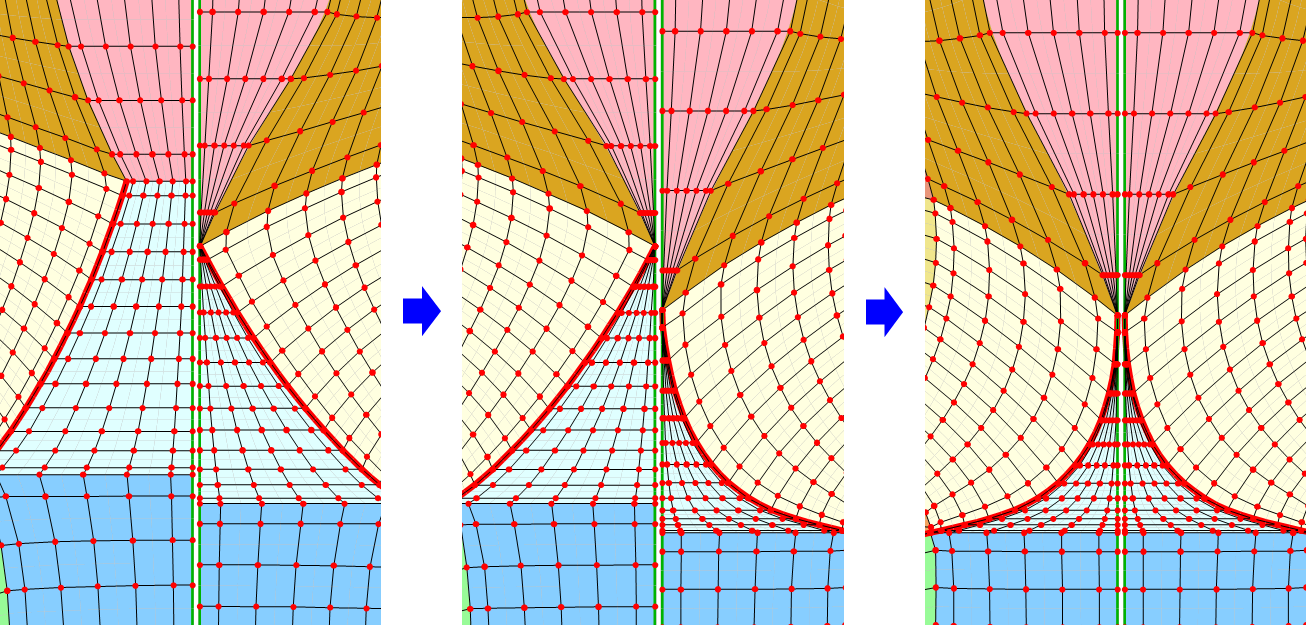
Figure: Mesh movement in a schematic representation of the heart valve leaflets. (Source: Takizawa Laboratory)
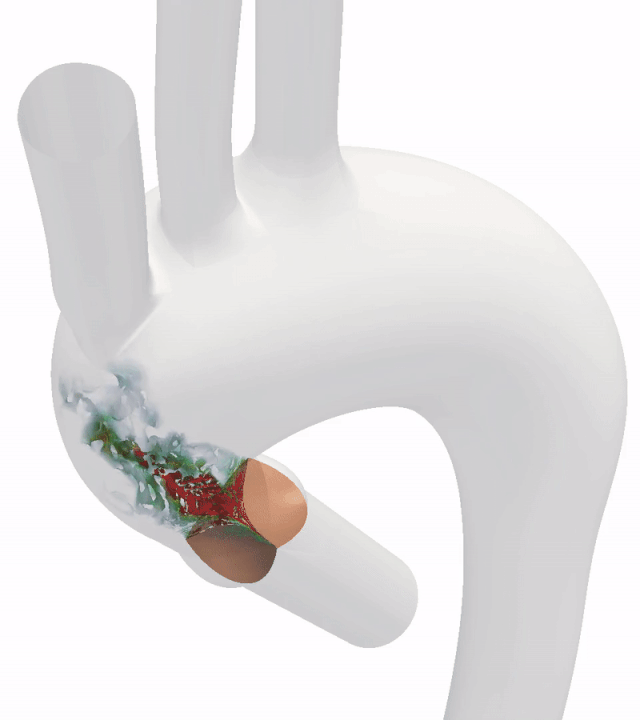
Figure: An example of blood flow analysis, flow in the aorta, including the heart valve. See Part 2 for details! (Source: Takizawa Laboratory)
In Part 2, Professor Takizawa will cover in-vivo blood flow analysis, which he has been focusing on in recent years.
☞Click here for Part 2
☞Click here for Part 3
Profile
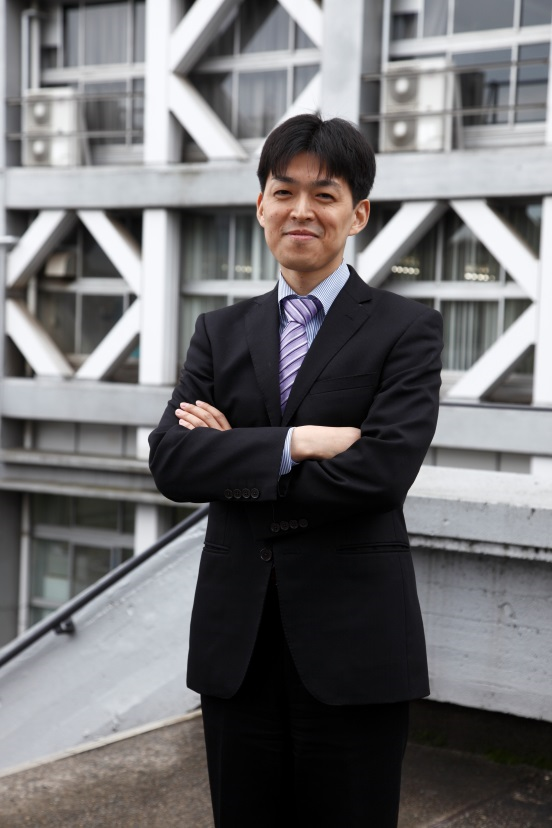 Kenji Takizawa
Kenji Takizawa
Professor Takizawa graduated from Tokyo Institute of Technology’s Department of Mechano-Aerospace Engineering in 2001 and earned his doctoral degree in science from the Department of Energy Science at Tokyo Tech in 2005. He became a research staff member at the National Maritime Research Institute in 2005 and held the positions of research associate and research scientist at Rice University starting in 2007. Professor Takizawa has been an associate professor at Waseda University’s Faculty of Science and Engineering since 2011. Specializing in computational mechanics, he studies a wide range of fields including fluid dynamics, structural mechanics and biomechanics. In recent years, he has gained global recognition and won numerous awards.
Major achievements
Journal articles
- K. Takizawa, T.E. Tezduyar, T. Terahara, and T. Sasaki, “Heart Valve Flow Computation with the Integrated Space–Time VMS, Slip Interface, Topology Change and Isogeometric Discretization Methods,” Computers & Fluids, published online, DOI: 10.1016/j.compfluid.2016.11.012 (2016)
- K. Takizawa, “Computational Engineering Analysis with the New-Generation Space–Time Methods,” Computational Mechanics, 54(2014) 193–211, DOI: 10.1007/s00466-014-0999-z
- K. Takizawa, Y. Bazilevs, and T.E. Tezduyar, “Space–Time and ALE-VMS Techniques for Patient-Specific Cardiovascular Fluid–Structure Interaction Modeling,” Archives of Computational Methods in Engineering, 19 (2012) 171–225, DOI: 10.1007/s11831-012-9071-3
- K. Takizawa, and T.E. Tezduyar, “Computational Methods for Parachute Fluid–Structure Interactions,” Archives of Computational Methods in Engineering, 19(2012) 125–169, DOI: 10.1007/s11831-012-9070-4
- K. Takizawa, and T.E. Tezduyar, “Multiscale Space–Time Fluid–Structure Interaction Techniques,” Computational Mechanics, 48 (2011) 247–267, DOI: 10.1007/s00466-011-0571-z
For other publications see here
Books
- Y. Bazilevs, K. Takizawa, and T.E. Tezduyar, “Computational Fluid–Structure Interaction: Methods and Applications,” Wiley, ISBN 978-0470978771, doi: 10.1002/9781118483565 (2013)
- Y. Bazilevs, K. Takizawa, and T.E. Tezduyar, “Computational Fluid–Structure Interaction: Methods and Applications,” Morikita, ISBN 978-4-627-67481-3, Translation from English: Y. Tsugawa and K. Takizawa. (2015)
Honors and awards
- Young Investigator Award, Japan Association for Computational Mechanics (2007)
- Fellow Award, Japan Association for Computational Mechanics (2012)
- Young Investigator Award, International Association for Computational Mechanics (2012)
- Thomas J.R. Hughes Young Investigator Award, ASME Applied Mechanics Division (2012)
- Young Investigator Award, Asian Pacific Association for Computational Mechanics (2013)
- Computational Mechanics Achievement Award, Japan Society of Mechanical Engineers (2014)
- Waseda Research Award (High-Impact Publication), Waseda University (2014)
- Young Scientists’ Prize, Commendation for Science and Technology by Japan Minister of Education, Culture, Sports, Science and Technology (2015)
- Web of Science Highly Cited Researcher (Engineering), Thomson Reuters (2015)
- Japan Research Front Awards 2016, Thomson Reuters (2016)
- Web of Science Highly Cited Researcher (Engineering), Thomson Reuters (2016)
- NISTEP Award, National Institute of Science and Technology Policy (2016)


